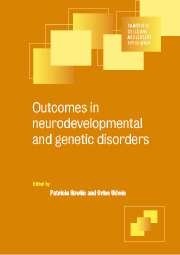Book contents
- Frontmatter
- Contents
- List of contributors
- Preface
- 1 Attention deficit hyperactivity disorder
- 2 Developmental language disorders
- 3 Reading and other specific learning difficulties
- 4 Metabolic disorders
- 5 Hemiplegic cerebral palsy
- 6 Autistic disorders
- 7 Down syndrome
- 8 Fragile X syndrome
- 9 Prader-Willi and Angelman syndromes: from childhood to adult life
- 10 Rett disorder
- 11 Tuberous sclerosis
- 12 Williams and Smith-Magenis syndromes
- Index
12 - Williams and Smith-Magenis syndromes
Published online by Cambridge University Press: 13 August 2009
- Frontmatter
- Contents
- List of contributors
- Preface
- 1 Attention deficit hyperactivity disorder
- 2 Developmental language disorders
- 3 Reading and other specific learning difficulties
- 4 Metabolic disorders
- 5 Hemiplegic cerebral palsy
- 6 Autistic disorders
- 7 Down syndrome
- 8 Fragile X syndrome
- 9 Prader-Willi and Angelman syndromes: from childhood to adult life
- 10 Rett disorder
- 11 Tuberous sclerosis
- 12 Williams and Smith-Magenis syndromes
- Index
Summary
Introduction
Williams syndrome and Smith-Magenis syndrome are both rare, genetically determined conditions with an assumed prevalence of 1 in 25 000 live births, an equal sex ratio and an association with learning disabilities, mostly in the mild to severe range. Both syndromes are associated with distinctive patterns of cognitive and behavioural characteristics, although in each case the pattern of characteristics is different and carries very different implications for adjustment in adulthood and for educational and behavioural interventions.
While rare, these syndromes are becoming better known among health professionals, and more and more affected individuals are being identified. These individuals are also quite likely to be referred to health and mental health specialists because the particular behavioural and psychological characteristics associated with the conditions place them at increased risk for difficulties in adjustment and psychopathology in both childhood and adult life. In recent years there has been a growth in research on the psychological characteristics, difficulties and needs of children with Williams syndrome, and to a lesser extent Smith-Magenis syndrome. Research findings are also beginning to accrue on the long-term course of these conditions and adjustment in adulthood. This is vital for parents and professionals in order to facilitate the sharing of information about appropriate educational and behavioural approaches, to inform intervention efforts and to help plan for adulthood.
Keywords
- Type
- Chapter
- Information
- Outcomes in Neurodevelopmental and Genetic Disorders , pp. 299 - 326Publisher: Cambridge University PressPrint publication year: 2002
- 3
- Cited by

